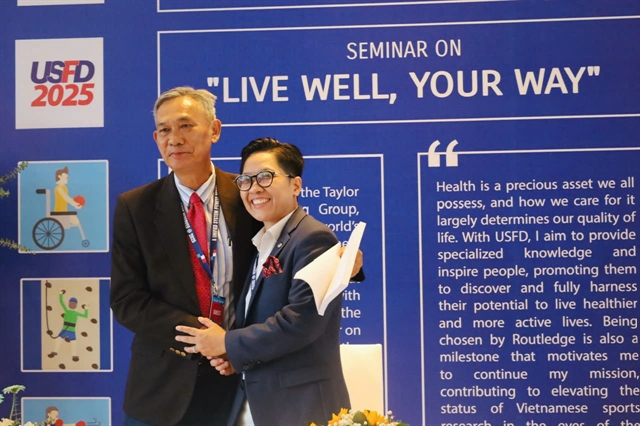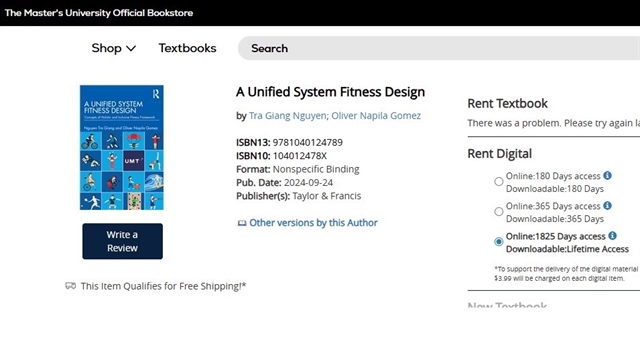 Inner Sanctum
Inner Sanctum

 |
| Nguyễn Trà Giang (left), PhD, presents the USFD book to Minister of Youth and Sports of Malaysia, YB Hannah Yeoh Tseow Suan. Photo courtesy of Jane Nguyễn |
Nguyễn Trà Giang, PhD, affectionately known as Jane Nguyễn, and her colleague Oliver Napila Gomez have achieved a significant milestone with the release of their book, A Unified System Fitness Design, published by Routledge. This work is rapidly gaining recognition across numerous universities in the US, setting a new standard in the fields of sports science and education. Thanh Nga sits down with Giang to explore this pivotal moment in her career and its implications for scientific research and sports education in Việt Nam.
Inner Sanctum: Could you introduce yourself briefly?
I am a professor and researcher specialising in sports science, with nearly 20 years of experience teaching and conducting research in over 35 countries. I proudly served as the first Vietnamese manager for the Thai men's ice hockey team, contributing to their impressive performance at the 2022 World Cup in South Africa.
Moreover, I am the first Vietnamese author to publish a sports science book, A Unified System Fitness Design (USFD), with Routledge in 2024 - a prestigious publisher with over 200 years of history.
Beyond the academic realm, I leverage sports as a tool for social change, focusing on projects aimed at gender equality, reproductive health, and the prevention of gender-based violence. In 2018, I initiated the “Stay Active, Happy Her, Happy Us” project, funded by the US State Department, to inspire girls to engage in sports, boosting their confidence and promoting community-wide gender equality.
Currently, I serve as Vice President of the Việt Nam Chess Federation, where I founded the Happy Chess Project in 2023 to support disadvantaged children.
Crucially, I’m pledging 100 per cent of the profits from USFD to fund free physical education and sports activities for underprivileged children across the country. This initiative aims to create positive impact in and out of the classroom, where knowledge and compassion intersect to foster sustainable education.
 |
| 'A Unified System Fitness Design', published by Routledge, the world's largest academic publisher. Photo courtesy of Jane Nguyễn |
Inner Sanctum: What motivated you to write USFD?
During my nearly two decades of experience in sports science across 35 countries, I noticed a troubling trend: when discussing physical qualities, many people, both in Việt Nam and around the world, view them as exclusive to athletes. Ordinary individuals, particularly children, women, the elderly and people with disabilities, often feel that they lack physical strength or that such qualities are beyond their reach.
This narrow perception deeply concerns me. I believe that health-related fitness is a precious asset that every individual can cultivate. My goal in writing USFD was to create a scientific, inclusive model suitable for everyone regardless of age, gender, occupation or living conditions.
In essence, I aimed to expand the notion of physical qualities and make them accessible to all, dismantle stereotypes about who can be physically fit, and offer a comprehensive scientific framework that empowers individuals to understand their physical potential. I want to inspire a healthier lifestyle and encourage everyone to live well.
USFD emphasises all facets of physical health, including cardiovascular endurance, muscular strength, flexibility, and coordination. These are elements I believe are as essential as traditional physiological indicators like height or weight. Surprisingly, many people only require “health certificates” based on limited physiological metrics. I argue that a broader assessment of physical qualities, reflecting one’s ability to perform tasks effectively and safely, is crucial.
 |
| Nguyễn Trà Giang, PhD, signs a book for Sakchai Pitakwong, PhD, former head of the Faculty of Sports Science, Burapha University, Thailand. Photo courtesy of Jane Nguyễn |
Thus, USFD serves as both an academic text and a practical model that can be applied in physical education, sports training, and community health initiatives, from schools to corporate and healthcare environments. I hope it becomes a valuable resource for trainers, teachers, coaches, and anyone interested in improving their health.
Most importantly, I aspire for the book to inspire individuals to recognise and cultivate their own physical potential, leading to healthier, more fulfilling lives.
Inner Sanctum: What steps did you and your co-author take in researching and developing the book?
The creation of USFD was a dedicated journey lasting over two years, integrating scientific research, practical experience and deep collaboration with my co-author.
As we explored physical fitness assessment and development models worldwide, we observed a common limitation: most models cater solely to athletes or specific demographics, neglecting the broader population. There were hardly any comprehensive and inclusive models applicable to everyone, from children and the elderly to people with disabilities and office workers.
Recognising this gap, we set out to construct the USFD manuscript. We developed our content by comparing international standards and referencing existing research, while also incorporating illustrative examples and practical applications.
Our vision was to make USFD more than just an academic reference; we wanted it to be a tool applicable in physical education, sports training and community health initiatives, one that could integrate into people's daily lives.
Ultimately, we submitted the manuscript to Routledge, where it underwent a rigorous review and evaluation process before its official publication.
 |
| Nguyễn Trà Giang takes photos with Associate Professor Đặng Hà Việt, former director of the Sports Authority of Việt Nam (second right). — Photo courtesy of Jane Nguyễn |
Inner Sanctum: Who is the book aimed at, and what benefits do you hope it will bring?
USFD is intended for a diverse audience, not just athletes or fitness professionals. Key groups include physical education lecturers and teachers, coaches, sports managers, educational institutions, businesses, health science students and anyone interested in improving their health.
My primary goal is to help individuals recognise that physical fitness is not exclusive to athletes but is an asset everyone possesses and can develop. I aspire for USFD to be a practical resource that encourages people to live healthier, understand their bodies better and take a proactive approach to their health.
Inner Sanctum: How did it feel to have your book published by Routledge, and what does it signify for the sports industry?
Learning that USFD was accepted by Routledge filled me with pride. For a Vietnamese scientist, being published by such a prestigious house is a remarkable achievement, not just for me personally but also for Việt Nam as a whole in the realm of sports science.
USFD’s global publication is both a personal triumph and a testament to the capabilities of Vietnamese sports science to make meaningful contributions on the world stage. It serves as a powerful motivation for me to continue my mission of spreading knowledge, fostering community health and elevating Việt Nam’s standing in international research.
I hope this book reaches not only professionals but also everyday individuals, offering them renewed energy and direction for a healthier, more positive lifestyle. To me, health transcends science: it embodies responsibility, love and a precious gift we can give upon ourselves.
 |
| UFFD is currently available at the library and sold online at the bookstore of the Master's University. VNS Photo Giang Bùi |
Inner Sanctum: How does the presence of USFD in American universities impact the image of Vietnamese sports research?
The inclusion of USFD in esteemed American institutions like Miami University and Master's University serves as a personal honour while symbolising a significant advancement for Vietnamese sports science. It affirms that Vietnamese researchers can produce work respected by the international academic community, showcasing Việt Nam's voice on the global stage with valuable, applicable contributions.
For our sports science industry, this recognition heralds a shift – a new image of a dynamic and integrated Việt Nam capable of standing alongside developed nations in sports research. This encourages young sports researchers in Việt Nam to gain confidence, ultimately enhancing our position within the international sports science ecosystem.
Inner Sanctum: Can you share more about your initiative to organise free sports activities for disadvantaged children?
I firmly believe that physical, sports and intellectual activities are transformative forces for social change. This conviction drives my relentless quest to provide equal opportunities for all children, particularly those facing challenging circumstances. Regardless of their background, every child deserves access to quality education, where sports and physical activities can help them discover their potential and value.
In our programmes for disadvantaged children, we strive not only to teach them how to play but also to instil a belief that they have the right to dream and the ability to develop like their peers.
This philosophy aligns with the essence of USFD – a model designed to broaden access to health and fitness for everyone, regardless of their circumstances. It emphasises that each individual can improve their health, energy, and quality of life with the right guidance.
Through both USFD and my community projects, I aim to convey a powerful message: “Live well your way”. Health and fitness are not privileges of a select few; they are universal rights. Everyone deserves support in reaching their fullest potential. VNS




